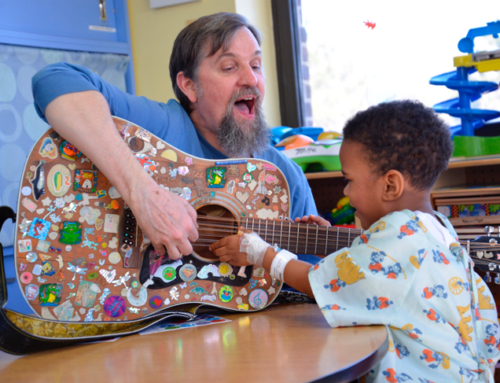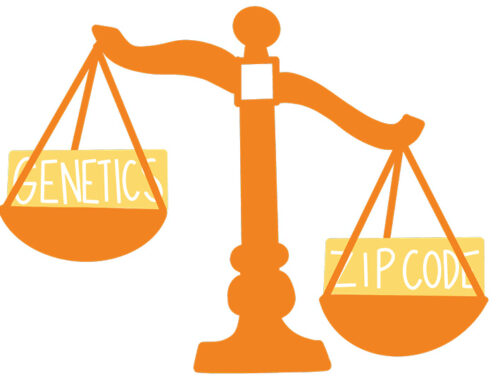Our Highlights
May You Learn and Share
The month of May is always filled with beautiful flowers blooming and much welcome warmer temperatures, but it is also full of many awareness days and ways to educate yourself on events going on in the medical community. Here at enCourage Kids, we want to make sure to celebrate and bring awareness to things that are in line with our mission and the pediatric patients we serve around the country. In this blog, you will be able to learn and share about many different awareness days in May, seeing how each disease or disability affects our community.
World Lyme Day (May 1st) // National Lyme Disease Awareness Month
Caused by tick bites alone, Lyme disease infects 300,000 Americans every year. Of those 300,000 infected, 75,000 are children. Some symptoms include fever, headache, fatigue, and a unique skin rash. More often than not, a person infected with Lyme disease has a difficult time finding the cause of these symptoms. An average patient sees five doctors over nearly two years before being properly diagnosed. However, if an individual is particularly concerned that they have lyme disease, they could always consider purchasing a lyme panel to see if that eases their mind slightly whilst they continue with their doctors appointments to get a conclusive opinion. Most cases of Lyme can be treated with antibiotics, about 40% of patients will end up with long-term health problems.
When you are outside, be aware of places where ticks are more present. These include grassy, bushy, or wooded areas. There are many EPA (Environmental Protection Agency) approved insect repellents that will help protect you from ticks when you are outdoors. Always check your clothing, gear, and body for ticks, as well as check your pets.
National Cornelia de Lange Syndrome Awareness Day (May 11th)
National Cornelia de Lange Syndrome (CdLS) Awareness Day exists to help individuals with CdLS receive an earlier diagnosis and to reduce the isolation families experience.
CdLS is a rare genetic disorder that affects intellectual and physical development. Children with CdLS usually have a low birth weight, are smaller in size and height, and have a smaller head circumference (microcephaly). CdLS occurs in approximately 1 of every 10,000 live births.
Some characteristics of CdLS include:
- Developmental delays
- They can range from mild to severe.
- Learning disabilities and severe language delays are often present.
- Gastrointestinal Involvement
- It is estimated that 85% of people with CdLS experience some type of gastroesophageal reflux.
- The pain that can accompany gastroesophageal reflux disease (GERD) can make eating unpleasant and lead to a variety of behavioral problems.
- Behavioral Issues
- People with CdLS may exhibit a number of behavioral problems such as self-injury, compulsive repetition, and/or autistic-like behaviors.
People with CdLs face common medical issues which can often result in hospital stays. These include: gastroesophageal reflux disease, heart defects, seizures, feeding difficulties, vision problems, and hearing loss.
Mental Health Month
The awareness raised by Mental Health Month plays an important role in fighting stigma, providing support, educating the public, and advocating for politics that support people with mental illness and their families.
Did you know that 1 in 5 adults in the United States experiences a mental health condition in a given year? That is 46.6 million people per year. Over half of all lifetime mental health conditions begin by age 14, and 75% by age 24.
1 in 5 children ages 13-18 has, or will have a serious mental illness. The average delay between the onset of symptoms and beginning intervention is 8-10 years. After noticing the symptoms, there are four things parents can do:
- Talk with your pediatrician
- Get a referral to a mental health specialist
- Work with the school
- Connect with other families
Mood disorders, including major depression, dysthymic disorder, and bipolar disorder, are the third most common cause of hospitalization in the United States for both youth and adults aged 18-44.
The most important thing that Mental Health Month aims to accomplish is to break the stigma of mental health, giving people who have mental health conditions more access to interventions and medical help. Mental health conditions go beyond your normal emotional ups and downs, they are medical conditions that cause changes in how we think and feel as well as in our mood. They are never a result of personal weakness, lack of character, or poor upbringing- a common misconception in society today. With proper treatment, people can realize their full potential and live a productive and healthy lifestyle. Treatment can include counseling, medication, outpatient or inpatient treatment facilities. You can even access Christian facilities if you so wish, such as Honey Lake, the number one Christian mental health program in the USA.
Celiac Disease Awareness Month
When you meet someone who is on a gluten-free diet, he or she may have celiac disease, a serious autoimmune disease. If someone with celiac disease eats gluten, an autoimmune response is triggered in the small intestine. Over time, this reaction can damage the small intestine’s lining and prevent absorption of important nutrients.
Did you know that 1 in 133 people in the United States has celiac disease? That is approximately 3 million people. And an astounding 83% of those with celiac are undiagnosed. When left undiagnosed and untreated, individuals with celiac are at risk for other serious health conditions, such as osteoporosis, anemia, thyroid disease, and even certain cancers. In the United States, it takes an average of 6-10 years to be correctly diagnosed with celiac disease. Early diagnosis is incredibly important for lowering a person’s chance of developing other autoimmune conditions.
Right now, the only treatment for celiac disease is a strict gluten-free diet.
Cystic Fibrosis Awareness Month
Cystic fibrosis (CF) is a genetic disease that causes persistent lung infections and limits the ability to breathe over time. More than 30,000 people in the United States currently live with cystic fibrosis and there are approximately 1,000 new cases of cystic fibrosis diagnosed every year. CF is diagnosed by age 2 in more than 75% of people.
CF is complex and the types and severity of symptoms can differ widely from person to person. Many different factors, such as age of diagnosis, can affect an individual’s health and the course of the disease. On average, CF patients take about 30 pills a day and spend much of their lives in and out of the hospital.
Due to research and incredible medical advancements, the life expectancy for a person living with CF has increased from 6 years to 48.8 years since 1960.
National Asthma & Allergy Awareness Month
Did you know that more than 60 million Americans are living with asthma and allergies? Let’s learn a little bit more about each and how they affect the day-to-day lives of Americans around the country:
Asthma:
Asthma is a lung disease that makes it harder to move air in and out of your lungs. Asthma currently affects more than 26 million Americans in the US, 6 million of those being children. It is the leading chronic disease in kids and is the top reason for missed school days. In 2013, children missed about 13.8 million days of school due to asthma.
Asthma rates and deaths are highly connected to poverty, air pollution, indoor allergens, poor healthcare, and not enough patient education. It causes over 2 million emergency room visits, 14 million doctor visits, 500,000 hospitalizations, and more than 3,600 deaths in a year. The annual cost of asthma in the United States is $82 billion, which includes doctor and hospital visits, medical costs, and trips to the emergency room.
Allergies:
A food allergy is a medical condition in which exposure to food triggers a harmful immune response. The symptoms of an allergic reaction can range from mild (itchy mouth, a few hives) to severe (throat tightening, difficulty breathing). The eight major food allergies include milk, egg, peanut, tree nuts, wheat, soy, fish and crustacean shellfish.
It is estimated that 32 million Americans have food allergies, including 5.6 million children under age 18. That’s 1 in 13 children or roughly two in every classroom. Additionally, almost 40% of children with a food allergy are allergic to more than one food. Caring for children with food allergies costs families in the United States nearly $25 billion annually.
Every three minutes, a food allergy reaction sends someone to the emergency room, and unfortunately, childhood hospitalizations for food allergies have tripled between the late 1990s and the mid-2000s. Because of this, if your child has a food allergy, it is important to check that your health insurance covers you for allergic reactions. The last thing you want after a trip to the emergency room is a hefty bill.
National Physical Fitness & Sports Month
National Physical Fitness & Sports Month exists to promote a healthy lifestyle and show children and adults how much exercise they should be getting each and every day. Children should be active for no less than 60 minutes of exercise a day, whereas adults are encouraged to engage in 30 minutes or more of physical activity. The benefits of exercise for children and adolescents include improved muscular fitness, bone health, and heart health. For adults, exercise can lower the risk of heart disease, type 2 diabetes, and some types of cancer.
Did you know that only 1 in 3 children are physically active every day? 74% of children ages 5-10 do not get enough exercise and 12.5 million kids aged 2-18 are considered obese. Unfortunately, many of those children will experience fat shaming, which can seriously impact their mental health. Taking part in this healthy lifestyle month will show children how to be more active, which can encourage them to let off steam and take care of their mental health. Sport plays a huge role in someone’s mental health and this month can show them ways to keep active wherever they are, whether it’s at home, school or elsewhere. 96% of elementary schools to offer no physical education classes, making it even harder for children to reach that 60 minutes of exercise every day, hence the reason for this month being so important.
Resources:
https://www.nami.org/Learn-More/Mental-Health-By-the-Numbers
https://www.cdc.gov/ticks/avoid/on_people.html
https://www.cdlsusa.org/raise-awareness/
https://www.cdlsusa.org/characteristics-of-cdls/
https://www.mdmag.com/medical-news/five-facts-about-huntingtons-disease
https://rarediseases.info.nih.gov/diseases/10510/juvenile-huntington-disease
https://healthfinder.gov/nho/maytoolkit.aspx
https://www.cdc.gov/healthyschools/physicalactivity/facts.htm
https://www.aafa.org/asthma-and-allergy-awareness-month/
https://www.aafa.org/social-media-tools/
https://community.aafa.org/set/shareable-awareness-images
https://www.cff.org/News/News-Archive/2015/May-Is-National-Cystic-Fibrosis-Awareness-Month/
https://www.cff.org/Get-Involved/
https://celiac.org/about-celiac-disease/what-is-celiac-disease/
https://celiac.org/about-celiac-disease/symptoms-of-celiac-disease/
https://www.beyondceliac.org/60forceliac/Fast-Facts-about-Celiac-Disease-Infographic/1448/
http://www.childrenslymenetwork.org/children-lyme/children-lyme-disease-infographic/
https://worldlymeday.wixsite.com/worldlymeday
https://worldlymeday.wixsite.com/worldlymeday/lyme-basics
https://www.foodallergy.org/life-with-food-allergies/food-allergy-101/facts-and-statistics



